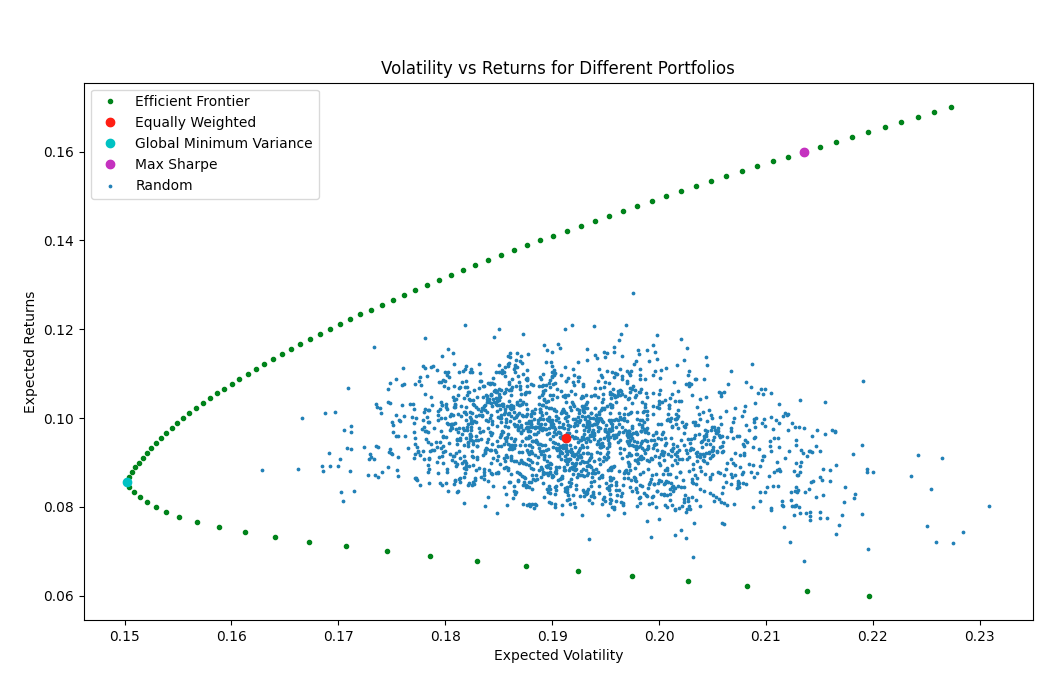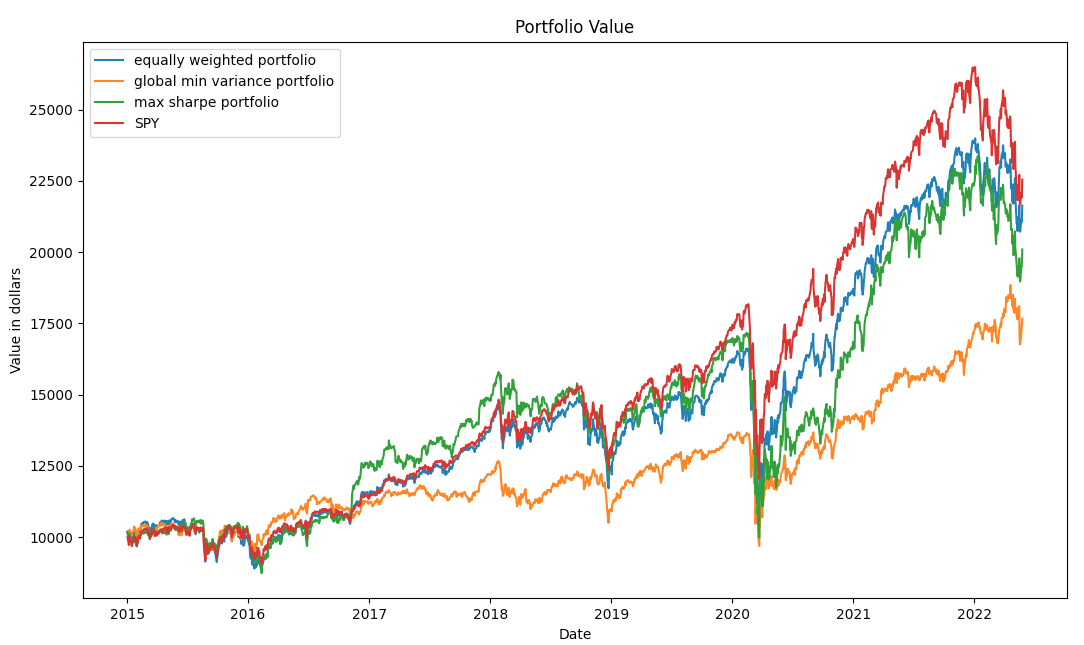This Github repository demonstrates the basic practices of the Modern Portfolio Theorem, including the Global Minimum Variance Portfolio, Max Sharpe Portfolio, and Efficient Frontier, all implemented in Python.
git clone https://github.com/zhuodannychen/Portfolio-Optimization
cd Portfolio-Optimization
pip install -r requirements.txt
python backtest.py
In backtest.py, the following values can be modified
TICKERS = ['SPY', 'QQQ'] # List of assets in your portfolio
TOTAL_BALANCE = 10000 # Initial balance
start_date = 'yyyy-mm-dd'
end_date = 'yyyy-mm-dd'
bound = (0, 1) # Change to (-1, 1) if shorting is allowedAssuming you have $100 and there are N assets, how much money should you put into each asset to generate maximum profit? The Modern Portfolio Theorem refers to a tradeoff between risk and return. How can we allocate capital to maximize the returns given a certain level of risk? Similarly, how can we minimize risk given a certain level of return? There is no unique solution, but rather, a set of solutions that form what is called the efficient frontier.
In our simulation, we use the following sectors: Technology, Consumers, Industrial, Materials, Financials, Energy, and Healthcare.
TICKERS = ['VGT', 'VDC', 'VIS', 'VAW', 'VFH', 'VDE', 'VHT'] # Vanguard ETFs of different sectorsThen, we randomize the weights of each asset to generate random portfolios.
As we can see, some portfolios performed better than other ones, meaning there has to be an optimized portfolio.
The equally weighted portfolio allocates equal amounts of capital to each asset.
def equal_weight(assets):
optimal = [1/len(assets) for i in range(len(assets))]
return optimalThe global minimum variance portfolio is the portfolio with the lowest risk. In Python, it can be solved with scipy.optimize.minimize .
def minimum_variance(ret):
def find_port_variance(weights):
# this is actually std
cov = ret.cov()
port_var = np.sqrt(np.dot(weights.T, np.dot(cov, weights)) * 250)
return port_var
def weight_cons(weights):
return np.sum(weights) - 1
bounds_lim = [(0, 1) for x in range(len(ret.columns))] # change to (-1, 1) if you want to short
init = [1/len(ret.columns) for i in range(len(ret.columns))]
constraint = {'type': 'eq', 'fun': weight_cons}
optimal = minimize(fun=find_port_variance,
x0=init,
bounds=bounds_lim,
constraints=constraint,
method='SLSQP'
)
return list(optimal['x'])Sharpe Ratio is the measure of the risk-adjusted return of a portfolio. A portfolio with a higher Sharpe Ratio is considered superior to its peers. However, expected returns and risks should be known with certainty.
The Maximum Sharpe Portfolio can be constructed using scipy.optimize.minimize, except we multiply -1 to the function to maximize the effect.
def max_sharpe(ret):
def sharpe_func(weights):
hist_mean = ret.mean(axis=0).to_frame()
hist_cov = ret.cov()
port_ret = np.dot(weights.T, hist_mean.values) * 250
port_std = np.sqrt(np.dot(weights.T, np.dot(hist_cov, weights)) * 250)
return -1 * port_ret / port_std
def weight_cons(weights):
return np.sum(weights) - 1
bounds_lim = [(0, 1) for x in range(len(ret.columns))] # change to (-1, 1) if you want to short
init = [1/len(ret.columns) for i in range(len(ret.columns))]
constraint = {'type': 'eq', 'fun': weight_cons}
optimal = minimize(fun=sharpe_func,
x0=init,
bounds=bounds_lim,
constraints=constraint,
method='SLSQP'
)
return list(optimal['x'])We start with a total of $10000 in our portfolio.
Between 2015-01-01 and 2022-05-27, SPY performed the best while the global minimum variance portfolio performed the worst. The Max Sharpe Portfolio had a lot more volatility, making it high risk and high reward.There are a couple of shortcomings with this project. First, we are calculating the portfolio performance based on past data we used to generate the mean and variance, so this is slightly biased. Second, portfolios should be rebalanced daily, weekly, monthly, quarterly, or yearly depending on the style. In our simulation, we held on to the same weight allocation for ~7 years. For the next steps, I will tackle these challenges.
This project is for research purposes and not investment advice.

